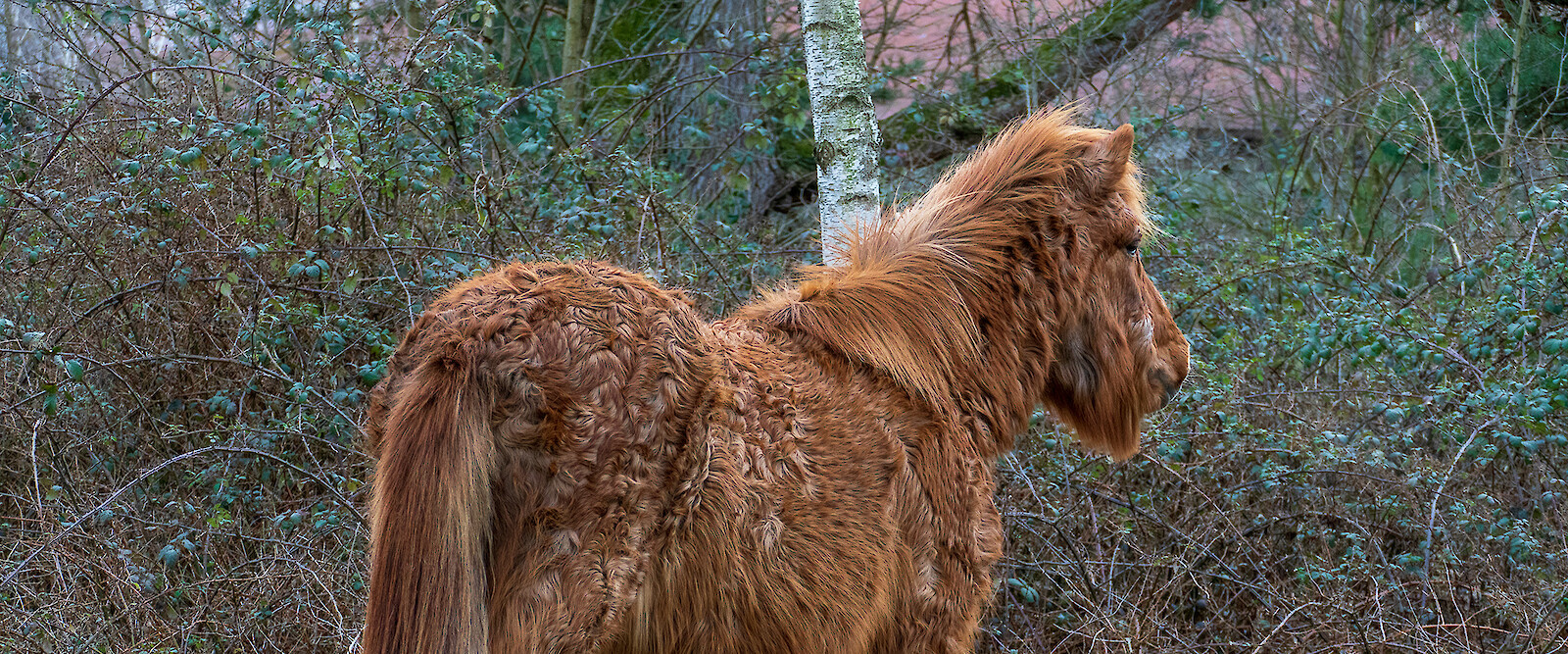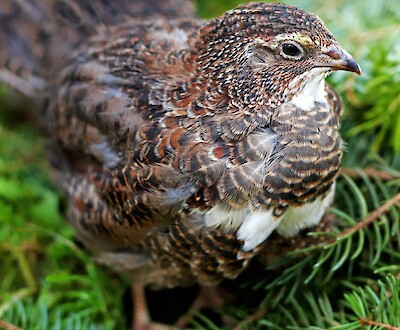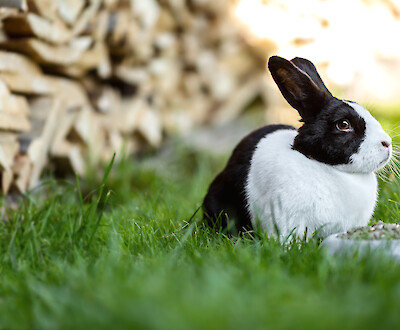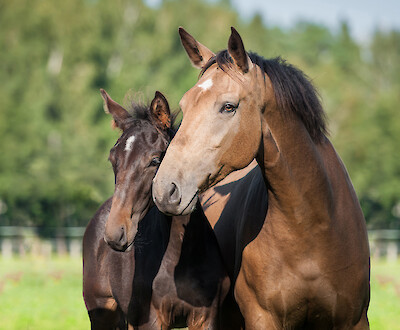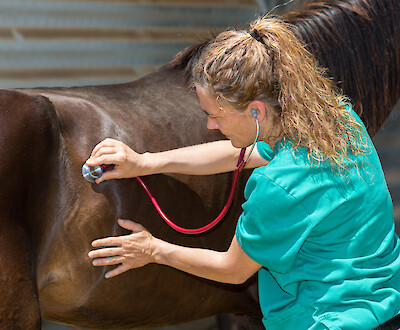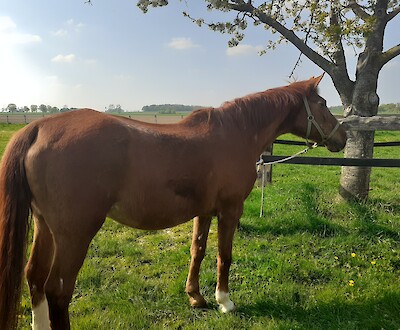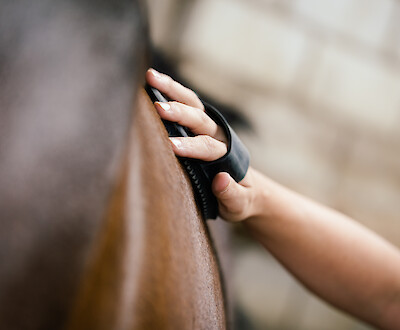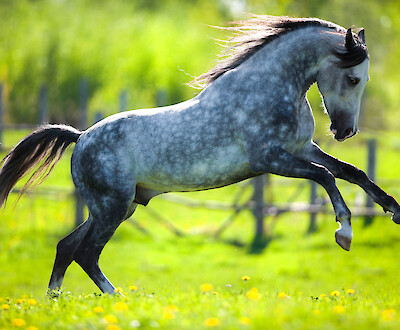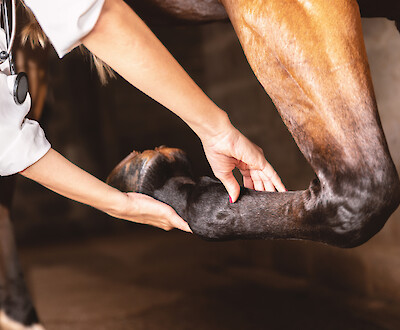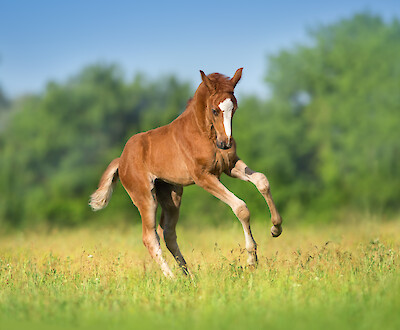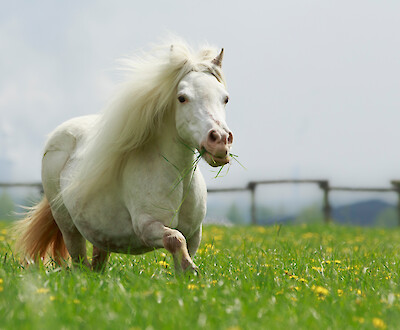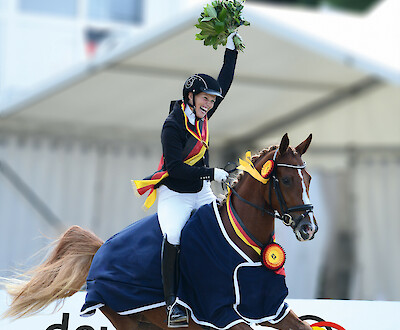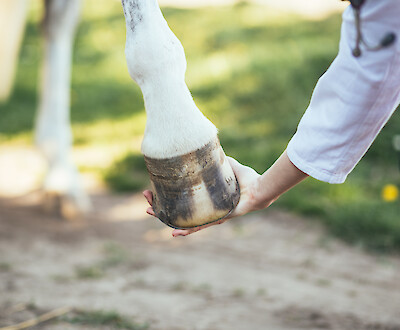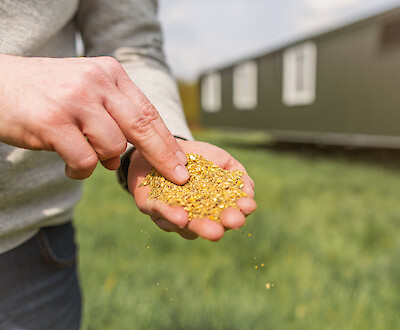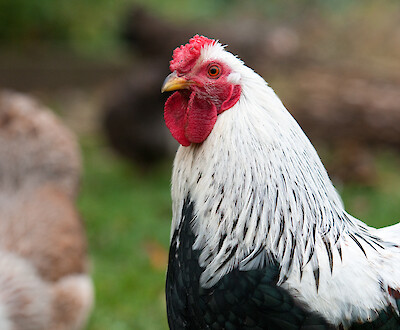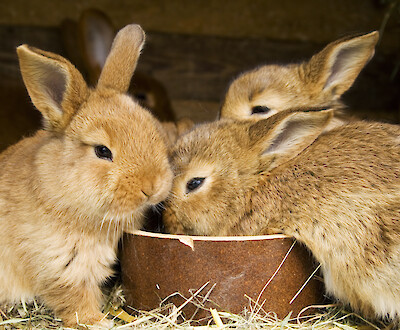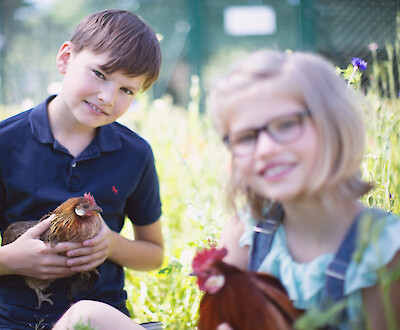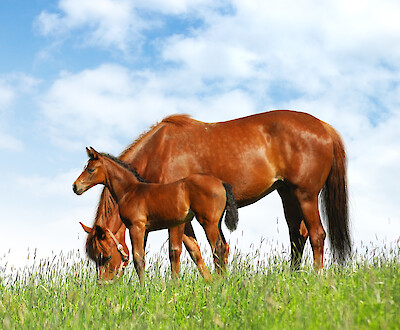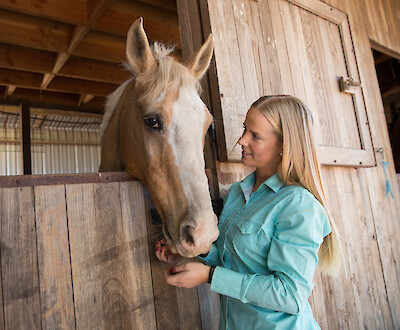Does your horse have a conspicuously long and dense coat, regardless of the season? Does it have problems with the change of coat or does it suffer from laminitis? Then you should take a closer look: These and similar symptoms often point to Equine Cushing's Syndrome (ECS). Cushing's syndrome - often referred to as Pituitary Pars Intermedia Dysfunction (PPID) - is a hormonal disorder in horses that affects their metabolism. The disease mainly affects older animals. Although Cushing's is not curable, with good management and loving care, "Cushing's horses" have a high life expectancy.
Many names, one cause: What exactly is ECS, PPID or Cushing's in horses?
Cushing's syndrome is a hormone disorder in horses. It is triggered by a benign ulcer on the hormone-producing p ituitary gland (hypophysis), which causes a malfunction. This is why Cushing's syndrome is also called PPID. This stands for a dysfunctionof the brain region called the pituitary pars intermedia(PPID for short). The pituitary gland is located in the diencephalon and is a hormone gland. Together with the hypothalamus, it controls the autonomic nervous system. In this context, it is responsible for controlling bodily functions that are not controlled voluntarily or consciously (e.g. heartbeat, breathing and metabolism).
Cushing's syndrome is a complex disease: Cushing's horses produce the hormone ACTH (adrenocorticotropic hormone) in excess. ACTH is normally produced in stressful situations and leads to the release of cortisol. This "stress hormone" puts the body on alert and mobilises the horse's carbohydrate stores. This makes additional energy available, which increases the blood sugar level. By releasing insulin, the horse tries to lower the blood sugar level again. However, this is not successful in Cushing's disease, as ACTH is permanently released. This leads to insulin resistance and the permanently high blood sugar level is suspected of causing inflammation throughout the body.
Symptoms: How to recognise Cushing's syndrome in horses?
The body of horses with Cushing's syndrome is constantly on alert. The permanently high cortisol level causes a variety of stress-related symptoms. These include:
- long, curly coat (so-called hirsutism)
- a weak immune system
- increased susceptibility to infections (e.g. cough, parasitic diseases such as mites or worms)
- wounds that heal poorly or slowly
- delayed change of coat (sick horses do not lose their coat even in summer)
- increased sweating, even in cool temperatures
- increased water intake and - related to this - increased urine output
- increased fat deposits on the mane crest, croup and above the eyes
- lack of back muscles in combination with a pot belly, possibly muscle atrophy
- bad hooves and/or hoof ulcers
Cushing's horses also have an increased risk of developing laminitis.
Cause: How does Cushing's disease develop in horses?
The cause of Equine Cushing's Syndrome is not yet fully understood scientifically. It is currently assumed that there is a genetic disposition in affected horses. It is noticeable that Cushing's often occurs as a secondary disease in overweight horses with Equine Metabolic Syndrome (EMS). Experts also discuss whether permanent stress and/or pain can cause the metabolic disease.
Age is also a significant risk factor: Cushing's syndrome mainly affects older horses. Studies show that 64 percent of all horses and ponies between 16 and 20 years of age suffer from Cushing's - many of them without visible symptoms. Up to the age of 30, the proportion rises to a frightening 95 percent (1).
Diagnosis: How is Cushing's syndrome diagnosed in horses?
The diagnosis of Cushing's syndrome is usually made by the veterinarian on the basis of the clinical symptoms. In addition, a blood test can be carried out to check the blood for the hormone ACTH. However, it should be noted that horses with chronic stress, pain or an acute infection usually also show an increased ACTH level without Cushing's syndrome being present (1).
A supplementary examination option is the TRH stimulation test: Here, the cortisol value is first determined and only the hormone TRH (thyrotropin-releasing hormone) is administered. If the cortisol level rises in the following 30 minutes, this is a sign of Cushing's (1).
Therapy: What can be done about Cushing's syndrome?
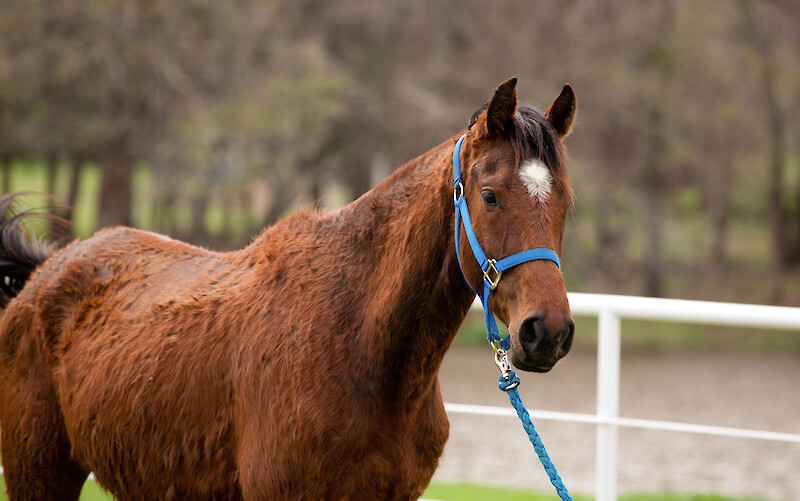
The therapy of Cushing's syndrome is complex and multi-layered. Treatment should therefore only take place after a concrete diagnosis has been made. You should also coordinate the procedure with your veterinarian. Even though Cushing's syndrome cannot be cured, affected horses have a long life expectancy if they are kept, cared for, exercised and fed properly.
Drug therapy: What helps with Cushing's disease?
Drug therapy is at the centre of treatment. Only when properly adjusted can the consequences of Cushing's syndrome be mitigated and the quality of life maintained. The drug approved for treatment uses the active ingredient pergolide, which is also used to treat Parkinson's disease. Pergolide promotes the release of dopamine. This in turn causes the pituitary gland to stop excessive ACTH production. A study from Switzerland came to the conclusion that daily administration of Pergolide leads to an improvement of symptoms in about 90 percent of horses with Cushing's syndrome (1). If well adjusted, the risk of laminitis can also be reduced.
Behaviour and management: Can I ride my Cushing's horse?
The way you manage your horse's daily life can have a big impact on the progression of the disease and the quality of life of your Cushing's horse. Therefore, you should take a close look at your horse's care, his regular activity and his daily routine in the stable and pasture:
- Reduce stress: Stress reduction is an important element in the therapy of Cushing's syndrome. Critically question the conditions in which your horse is kept and trained in order to identify and eliminate possible sources of stress. What makes your horse hectic? Does he feel comfortable in his herd? Can it eat in a relaxed manner or is it constantly sent away by higher-ranking horses? Is he getting enough food or are the breaks between feeds too long? Find answers to these and similar questions and help your horse relax.
Also, adjust training intervals to your horse's needs - don't overtax him, but keep him moving as much as possible. After all, exercise is important for the metabolism and fat burning.
- Coat care: As horses with Cushing's syndrome have problems with the coat change, you should pay close attention to the coat care and shear if necessary. This will prevent heat stress and reduce excessive sweating. At the same time, you can always keep an eye on possible skin changes and recognise parasite infestations at an early stage.
- Hoof care: Due to the increased risk of developing laminitis, regular hoof care is also of great importance for horses with Cushing's syndrome.
Feeding: How do I feed a Cushing's horse?
Adjusting the feed has a key role in the therapy of Cushing's syndrome. A change in feed serves to prevent a further increase in blood glucose levels.
What can a Cushing's horse eat?
The focus of an appropriate feeding of Cushing's horses is a ration reduced in sugar and starch. Therefore, the avoidance of cereals is central to the feeding of horses with Cushing's syndrome. Cereals are rich in starch. The energy of starch causes the blood sugar level to rise, which must be avoided at all costs in Cushing's horses. Therefore, always remove cereals from your horse's diet.
During the grazing season, make sure to feed pasture grass only sparingly. This is especially important in spring, when the pastures are still "fat" and have a lot of grass. But also in autumn, when the grass is already short, the days are cold but the sun still shines for a long time. The reason: In both situations, the fructan content in the pasture grass is particularly high. Fructans are energy-rich carbohydrates ("sugars") that are usually immediately stored as fat by horses with Cushing's syndrome due to insulin resistance.
Depending on the type of grass and the time of cutting, hay can also have a high sugar content. In order to keep a close eye on the sugar or energy intake via the hay, it is recommended to (regularly) examine the feed (2). Various chambers and laboratories offer corresponding analyses (e.g. LUFA Nord-West). You can order a discounted examination here.
If the feed analysis shows a high sugar content, you can wash out the hay to reduce the sugar content. Please note, however, that washing out the hay also results in the loss of important vitamins, minerals and trace elements that the horse needs to live. Therefore, make sure to supplement the feed with a high-quality mineral feed (e.g deukavallo Mineral). In this way, you can prevent an undersupply of important nutrients (3, 4).
What is the best feed for Cushing's horses?
The first step in creating a cushing-appropriate ration is to change your concentrates to grain-free varieties (e.g deukavallo Top Gastro or deukavallo Grain-free 21). A grain-free, and thus low-starch and low-sugar formula does not cause the already high blood sugar level of horses with Cushing's syndrome to rise significantly.
It is important to emphasise that an energy- or nutrient-poor feed does not necessarily have to be chosen. After all, especially older Cushing's horses are often very thin and therefore need energy to maintain their bodily functions. In order to counteract muscle loss, it is important that you not only cover your horse's energy needs, but also ensure that it receives a high quality protein supply (e.g deukavallo Linseed Vital or deukavallo Top Gastro).
To reduce inflammatory processes in the body of Cushing's horses, omega-3 and omega-6 fatty acids have proven to be effective, as well as vitamin E with its antioxidant effect. These are found, for example, in linseed oil. The energy-rich oil from linseed - the main ingredient in deukavallo Linseed Vital - is also rich in energy and is therefore suitable for fat-rich supplementary feeding of thin Cushing's horses in which the current weight is to be maintained.
Horses with Cushing's syndrome often suffer from shaggy, weakened and damaged hair. At the same time, they have problems with the change of coat. An additional administration of essential amino acids such as lysine and methionine usually helps. They strengthen the hair from the inside and support the development of a natural hair function. Corresponding additives can be found in cot feeds (e.g deukavallo Linseed Vital) as well as in tailored supplements (e.g deukavallo Biotin + Zinc or deukavallo Vitamin E + Selenium).
In the case of dental problems, which often occur in old horses, hay cobs should form the basis of the feed. This way, even older animals get enough raw fibre without having to chew a lot. Here, too, you should pay attention to a low sugar content (e.g deukavallo hay cobs).
Conclusion: Equine Cushing's Syndrome in horses
- Equine Cushing's Syndrome (ECS) is a hormonal disorder that puts horses in a permanent state of alert, raising blood sugar levels and negatively affecting metabolism.
- Studies show: More than half of horses older than 15 years are affected.
- Typical symptoms of Cushing's disease are: dense, long and curly coat that does not fall out, heavy sweating, fat pads on the mane crest and croup, muscle wasting and a pot belly.
- The cause of Cushing's is unclear. The most probable is a genetic susceptibility as well as a possible development as a result of EMS, triggered by an excessively high-sugar and starch diet. Stress is also discussed as a cause.
- In treatment, the combination of medicinal therapy in conjunction with stress reduction, optimisation of husbandry and training as well as a change in feed has proven successful.
- When feeding Cushing's horses, attention should be paid to a grain-free and starch- and sugar-reduced ration design. Concentrated energy for underweight horses should come from feeds containing oil and fat, which prevent a rise in blood sugar levels.
Misfortune seldom comes alone: Cushing's disease and laminitis
Equine Cushing's Syndrome (ECS) is often accompanied by laminitis. It is estimated that 70 to 90 percent of all cases of laminitis in Germany are caused by the metabolic disease. The disturbance of the sugar metabolism in Cushing's horses means that they are particularly at risk of developing laminitis (1).
- You can find more information on laminitis in our article " Recognising laminitis in horses in time, treating it correctly and preventingit".
Image sources: © HeiSpa - stock.adobe.com (top slider) / © Terri Cage - stock.adobe.com
Contact person

Barbara Wefers
Contact person




